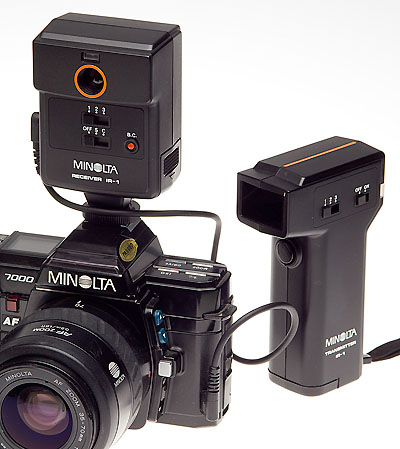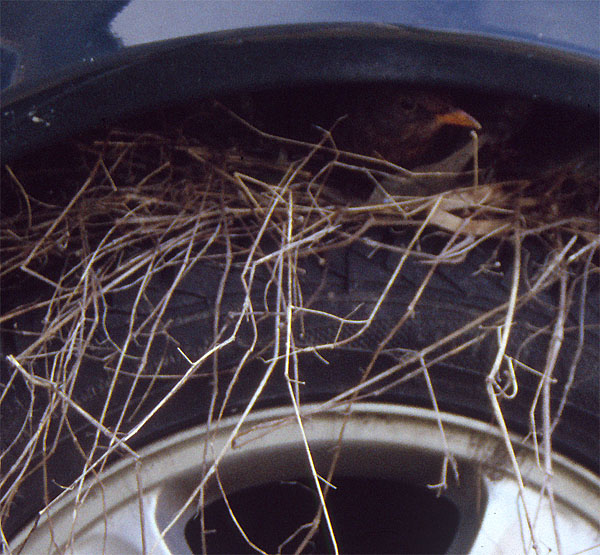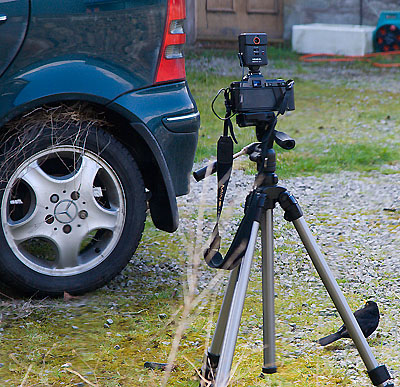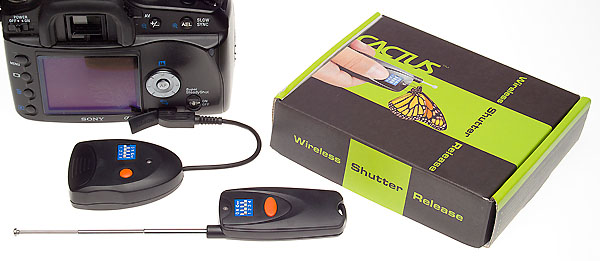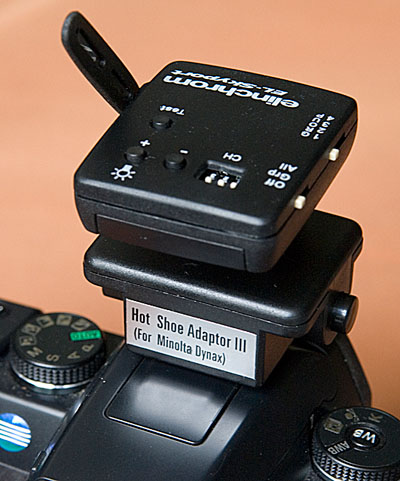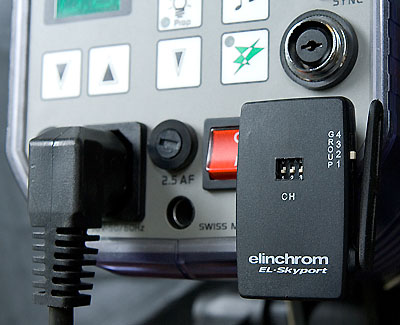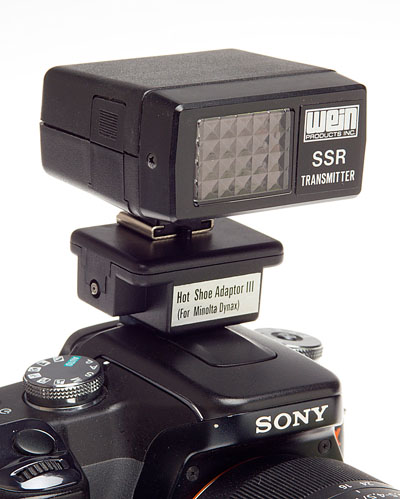Remote possibilities
This review from the Summer 2007 edition of Photoworld has been expanded here, and covers the Remote Release IR-1n kit along with third party remote triggers and flash synchronisation options for the Alpha system.
AT THE end of March we were plagued by a pair of blackbirds which insisted on building nests in the wheel arches of our car, no matter how often we destroyed the nest or whether we moved the car. Eventually, I decided to photograph this, and dug out the IR-1n infrared remote trigger kit from many years ago.
This remote trigger was made for X-700 series and the first AF SLRs as the IR-1. My IR-1n kit has both the cable for the threaded centre of the X-700 type shutter button, and one which fits the Remote socket of the 7000, 9000 and so on. The Receiver fits in the flash shoe, and was never updated to have a new-type shoe. Mounted suitably, it remained functional for the entire life of the Dynax model line of film cameras.
What had not occurred to me was that the digital SLRs were incompatible with the system. It turns out that they need two stages of activation, once for the focusing, a second time to fire the shutter. The Remote Cords RC-1000S and RC-1000L incorporated this from the very start, and are unchanged from 1985. The IR Trigger kit just fires the shutter. It will operate in a small reflective environment like a room without line of sight, but it will also trigger many studio flash units (see comments below on infrared triggers). In a large area or outdoors, it is best used with line of sight, and the receiver which fits the camera accessory shoe can be rotated to align. I have had no problems working up to 100 feet away in daylight with the IR-1n.
To get acquainted with it after many years of zero use, I dug out a 7000 body and a roll of slide film, the IR-1n kit, and manually prefocused the set-up as required. I sat indoors, looking through a window to see when the blackbird came to the nest. The camera was fitted with a 35-80mm AF zoom set to manual focus, carefully adjusted to just in front of the wheel arch, as my timing was supposed to catch the bird as it entered or left.
Of course, despite many exposures where I was convinced the wary female blackbird would be right out in front of the wheel arch (and in the plane of focus I had set) every shot managed to show no bird at all or a beak peeping out from the shadow. There was just enough delay on the camera firing (about 1/15th with the 7000) to make sure I missed the intended shot and got just a bit of the tail disappearing into the shadows.
The Fujichrome 400X film, while a very good material with grain more like an old 100 slide film, was so disappointing compared to the detail I now expect from digital. What you see top is a full frame, and above, a crop. These are scans to high quality on the Minolta Scan Multi Pro. We are so used to the different dynamic range and noise or grain qualities of digital SLRs these days, it’s easy to forget how even the latest slide emulsion can prove fairly crude by comparison.
In fact the picture I took of the camera in position, using my A100 with CZ 16-80mm through a window, shows the blackbird rather more clearly…
Solutions
There is a crude modification possible with the IR Receiver which wires the unused focus trigger connection to the release side. It is not advised and may possibly damage DSLRs. It has been detailed on some forums (dPreview, Dyxum) but I won’t repeat it here. There are better solutions available now at low cost.
A month or two after our unsuccessful attempt with the blackbird, neat little wireless control remotes made specifically to work with all Minolta and Sony Alpha cameras started appearing on internet (eBay).
The Cactus Wireless Shutter Release works with all Dynax, original AF models, and Dimage 5/7/A. It costs $39.95 plus $5 postage from GadgetInfinity of Hong Kong – www.gadgetinfinity.com.
These very small Chinese made Cactus brand remote controls have multiple channels, and two-stage triggering which allows you to focus the camera before releasing, just like using a remote cord or the camera itself. There are other makes and they all look similar. ‘Cactus’ is well packaged and has clear instructions.
I ordered one for $39.95 plus $5 shipping (US) from Hong Kong vendor Gadgetinfinity, who had proved reliable in the past with flash and lens mount adaptors. It arrived within five days, not the ten suggested on their website.
There is no indication whether the radio frequencies used are approved for the UK, but up to 16 channels can be selected on both transmitter and receiver allowing several users to work in the same location. The familiar four dipswitches are not a rapid way to change from firing one camera to another, but at this price, anyone wanting to do multiple set-ups could buy a few kits and have a separate trigger for every camera.
The transmitter is about the size of a car key remote lock unit. The receiver is a little larger. Both take unusual batteries which will be hard to get, and the vendors state that the fitted batteries are for test purposes only – they are not expected to last. The battery covers and fittings are a weak point too.
The receiver has no mounting facility, it just plugs into the remote socket and dangles. It weighs almost nothing and this is hardly a problem. The operating range of the Cactus unit indoors, using a straight unobstructed corridor 75 feet long with line of sight, turned out to be 15 metres maximum. This is nothing like the range of expensive units like the PocketWizard. Really, it’s a replacement for a remote cord with the benefit of multiple channels and a little more working distance. Don’t expect to mount your camera on a tower crane and fire it from the ground. You could mount the camera on a hand-held alloy pole and trigger pseudo-aerials with vague aiming fairly easily, no wires needed. Anyone who can hold a 15 metre pole should take up tossing the caber.
‘Remote’ but no triggers
Since the kit arrived at the beginning of a period of almost unbroken rain it was not advisable to set up a camera outside and wait for wild visitors. As to whether our visitors are really wild, we are not sure. The garden has its own family of rabbits, innumerable birds, frogs, toads, squirrels, hedgehogs, bats and our hens. The hens hardly need a remote control – opening a door is enough to get the entire rabble around your feet – and the rabbits happily trim the grass with one eye on people and dogs. Bat photography is impossible without supernatural reflexes, and it would take days of waiting for a squirrel to drop in or a hedgehog leave the undergrowth.
After a few experiments with a remotely placed camera and things to tempt rabbits (if the hens didn’t get there first) the best remote solution turned out to be the obvious one – a remote lens! There has been no possibility of putting a camera out unattended since then as hens are very clever at hiding their nests, and one successfully produced 15 chicks from an unauthorised nesting-place. Any bait put out for anything gets swarmed over; anything left around which can be perched on gets perched on (and decorated from the exit end of the food processing system at the same time) .
Why bother rigging up remote controls when you can sit quietly with a 500mm RF mirror lens and wait for the subject to arrive?
Photo by Shirley Kilpatrick, Konica Minolta 5D, ISO400, 1/100th at f/8, hand held with AS active.
The 500mm f/8 mirror lens comes into its own on the digital format, acting like a 750mm, and from the ten foot distance which the younger rabbits consider safe allows a frame-filling portrait.
The new wireless remote is so much smaller than the old IR trigger kit, it can be popped into a side pocket of the camera holdall, and no doubt the right subject will come to light. When the IR-1 was first introduced I placed an X-700 with fisheye 16mm in the middle of a horse trial course, right under a fence, and fired it from beyond the barriers. My trust in insurance, or good fortune, is not so great today!
Flash without cords
While the Minolta-Sony flash system is wireless in its own right, studio flash these days is rarely connected using PC sync cords. Everyone uses either an infrared trigger, or a wireless kit. The most popular is the PocketWizard. The benefits of wireless are that flash units placed further away, behind solid objects, can be triggered reliably. Infrared sync often means being in line of sight
Gadget Infinity also supply the Hot Shoe Adaptor III, shown below in use with Elinchrom Skyport wireless flash triggering and with a Wein SSR infrared flash trigger. This adaptor also has a PC (Prontor-Compur, nothing to do with computers!) coaxial flash sync terminal, for plugging in any regular modern flash cable. There are many other vendors for these products, I just happen to have excellent service with delivery in under 5 days every time to the UK (they state 7-10) and perfect products, receipts, paperwork etc from this vendor.
The Elinchrom Skyport RX Transmitter is dedicated to operating the multichannel RX wireless studio flash system. Flash power can be controlled from the camera module. We have tested this with the Alpha 100 and synchronisation is perfect.
There are many similar cheaper systems being sold from Hong Kong, obviously not dedicated to a flash system like this, just able to trigger a remote flash and replace a sync cable.
One option open to Dynax owners to fire studio flash is the well-established old infrared trigger. Since my Elinchrom heads have IR sensitive slave cells, I can use my Wein SSR Transmitter for triggering flash and it’s really just as useful as any modern wireless solution in the confines of a normal room or studio. It is considerably more useful in industrial buildings and outdoors, since it has a range of 600 feet (when used with its own receiver unit). The range is much less when triggering IR-sensitive slave cells which are not so closely matched to the transmitter.
These transmitters can not be used to trigger current Minolta/Konica Minolta/Sony AF flash units remotely as there is no provision for cable sync. The Wein receiver cells are not designed to be used with portable flash of this type. I have never tested the operating limits of Minolta/Sony wireless flash, as I have always been working in an interior space – a large room at the most. It is stated in the specifications that the slaved wireless flash units should be within 5 metres of the camera/subject/each other.
To fit any type of third party trigger to the Dynax or Alpha models, it is necessary to convert to a regular hot shoe, which is done via the Minolta FS-1100 adaptor or a similar item as shown here, mounted between the camera and the third party accessories. The ‘Hot Shoe Adaptor III’ is best located on eBay by searching for ‘Minolta FS-1100’ and adds a sync socket as noted above, which the current Sony/Minolta version lacks. Gadget Infinity sell them directly as well, though many people just look for the best eBay price. The original 1990 FS-1100 actually did have a sync socket, it just disappeared at a certain point in the early 1990s without the model number being changed. The genuine Minolta item is much smaller.
You can make an infrared flash trigger from any small flashgun. Although it’s probably hard to find now, litho printers used to have a clear red adhesive tape used for masking printing plate negatives. It is available in rolls. Find a friendly local litho printer, and get a few inches of this tape, enough to put four layers or more on the front of the flashtube window. This will cut down the flash to a dim red glow but it will still trigger Bowens (Bogen), Elinchrom and most other good professional studio strobes via their slave cell. Of course you can do it the expensive way – a piece of geniune Wratten infrared filter gel! – or the dirt cheap way… a piece of unexposed, processed E6 slide film.
Though it is a little less permanent, you can also fashion a simple filter hood for the pop-up flash of your Dynax 7D, which can be controlled in manual power independently of the camera’s settings. The 5D and Alpha 100 pop-up flashes lack manual power control, and always fire a pre-flash, which prevents this option.
– DK

